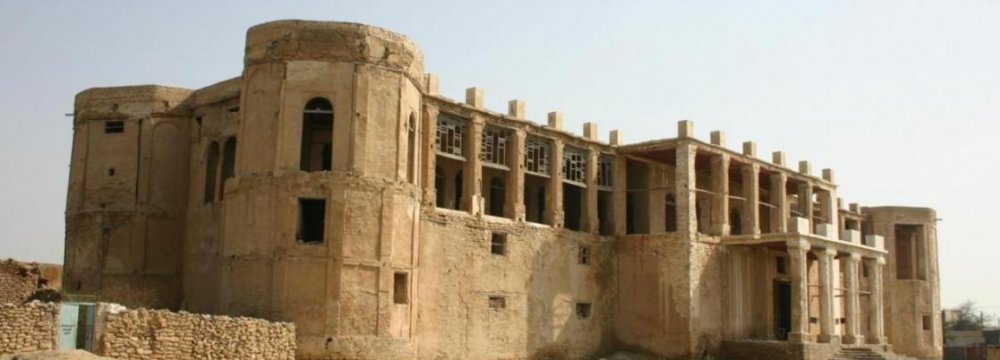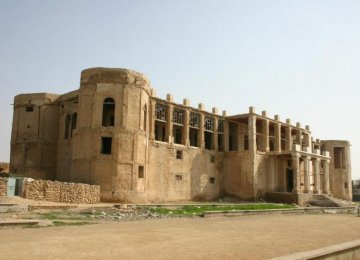Bushehr (or Bandar-e-Bushehr) is the capital city of Bushehr Province, Iran. It was previously known as ‘Ram Ardashir Antiochia in Persis’ and ‘Bukht Ardashir’.
Bushehr lies in a vast plain running along the coastal region on the Persian Gulf coast of southwestern Iran.
Bushehr is one among the most strategic regions of Iran both militarily and commercially, due to its accessibility to the Indian Ocean and world’s free waterways and hence drrew the interest of many conquerors and colonialists thought history.
Its tumultuous history has left behind a vast and varied heritage, making it fascinating place to visit.
Rais Ali Delvari
Of the numerous places to visit the house of Rais Ali Delvari stands out. Located in Delvar, near Bushehr, it has been converted into an ethnological museum. Rais Ali Delvari’s personal items, as well as historic documents of his time, various types of guns and horse caparisoning are exhibited in this museum.
Rais Ali Delvari was an independence fighter and anti-British colonialism activist now remembered as the national hero of Iran, who organized popular resistance against the British troops, which had invaded Iran in 1915.
Rais Ali, son of Rais Mohammad, was born in 1882 in the suburb of Bushehr. In the age of constitutionalism, he was 24, chivalrous, brave, unparallel in sincerity and famous for patriotism and reliance upon God. Subsequent to British occupation of Bushehr, Rais Ali courageously resisted the aggressors and imposed heavy defeats on them. After occupation of Bushehr, British forces decided to take over Delvar, a place they had earlier experienced heavy defeats. Rais Ali and his companions fought the occupiers who were nearly 5000 in number and routed them . The uprising of people of Tangestan prolonged nearly for 7 years in which Daliran Tangestan (the brave of Tangestan) pursued two goals: guarding Bushehr, Dashtestan and Tangestan as their habitat and preventing the foreign forces from infiltrating the country and securing the independence of the country. The noble Rais Ali Delvari was eventually attacked from behind by a traitor and martyred on September 2, 1915, when he was 33.
House of Malek
The mansion dates back to over 100 years ago and, covering an area of 400 square meters; it is situated 5 km away from the city of Bushehr.
It was built by French architects and has gone through renovations and changes various times.
Shaghab Cemetery
The historical graveyard in the central area of Bandar-e Bushehr (Port of Bushehr) has been discovered about a year ago by Iran’s Cultural Heritage, Handicrafts, and Tourism Organization (ICHHTO).
The skeletons have been buried in different size cream color vessels some of which have scripts on them. The vessels are indications of Zoroastrian methods and rituals for burying the dead. Stone square-shaped coffins are also among the discovered items.
General’s Tomb
The obelisk is the tomb to a British general who was killed by Iranian troops in 1856 whose name is not clearly known and is a matter of dispute between historians.
History
During the 1st and 2nd millennium BC, the Bushehr Peninsula was a thriving and flourishing seat of civilization called “Rey Shahr”. Many relics have been found in this regard related to the Elamite era and the civilization of Shoush (Susa).
These structures of “Rey Shahr” are said to be related to Ardeshir of Sassanid dynasty and “Rey Shahr” was formerly known by the name of Ram Ardeshir. Thereby through the passage of time came to be called Rey Shahr and thence Bushehr.
From between the 18th century through to early 20th century it was variously under the influence of European colonialists.
Today Bushehr remains among the most important ports in the Persian Gulf. It has an international airport, and highways connect the city to Ahvaz to the northwest and Shiraz to the northeast. A secondary coastal road links Bushehr to Bandar-e Abbas to the southeast. The old section of central Bushehr has many examples of traditional Persian Gulf architecture from the period 1870 to 1920.
Bushehr is an export market for farm produce from the neighboring and fertile Fars Province. Bushehr’s industries include seafood canneries, food-processing plants, and engineering firms. The Iranian navy maintains a base here.
Climate
Bushehr, being located on the hot Persian Gulf coast, has a desert climate though it does receive far more rainfall than most Persian Gulf cities. Rainfall, however, is confined to the period from November to February, when temperatures are pleasantly mild, and extremely erratic, with some years having as little as 65 millimeters and others such as 1957-1958 and 1997-1998 as much as 700 millimeters.
Appearance, Language, and Culture
In previous centuries, many Africans settled in Bushehr. Although there is no discernible linguistic influence from Africa in Bushehr, there are cultural and genetic influences. The southern Iranian people are dark skinned and have traces of Arab accent in their dialect, but they speak and write Persian.
Bushehr’s most known handicrafts are carpets, Kilim, Gabeh (a traditional form of carpet), felt, mats, baskets, Giveh (a local footwear), brooms, earthenware, hookahs, musk, and fishing nets.
The local music and dancing has strong African influence. The most noteworthy are their local anthems such as Sebalo, Sharveh (also Sherveh), and Yazleh.
Some of the melodies pertaining to the music of Bushehr dates back to 1,000 years ago. Locals of Bushehr use drumming, which recalls sea and sailing, in their religious ceremonies. Other major musical instruments in Bushehr are Ney Anban (bagpipe) and Ney Jofti (double pipe).





